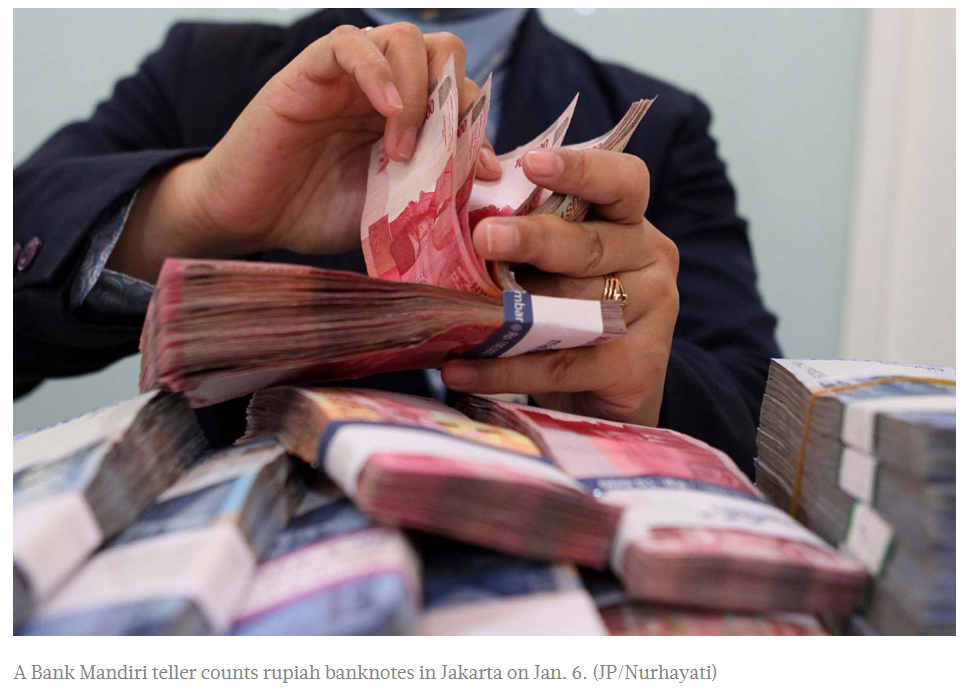Indonesian banks have sufficient liquidity despite loan restructuring, pandemic: Economists
The liquidity of Indonesian banks will remain in check despite economic risks brought by the COVID-19 pandemic and loan restructuring program that defers credit repayments, economists have said.
Fitch Ratings director for banks Gary Hannify said Indonesia’s 12-largest banks had ample liquidity as reflected in liquidity coverage ratios of about 180 percent at the end of 2019, adding that the industry had above the 100 percent minimum liquidity requirement in recent years.
The liquidity coverage ratio is the requirement in which banks must hold an amount of high-quality liquid assets that is enough to fund cash outflows for 30 days.
“We believe that lower loan growth together with various relief measures introduced by the central bank should help to mitigate any potential pressure on funding and liquidity as a result of the coronavirus,” Hannify told The Jakarta Post on Monday. “We expect these ratios to continue to be maintained with a satisfactory buffer throughout 2020.”
Loan growth reached 7.95 percent year-on-year (yoy) in the first quarter, higher than the 6.08 percent recorded at the end of last year. However, no new loan demand was recorded in the period as the growth came from the disbursement of existing credit facilities, Financial Services Authority (OJK) chairman Wimboh Santoso said on Monday.
The OJK and Bank Indonesia (BI) previously set a loan growth target of around 11 percent this year. The central bank recently slashed its projection to between 6 and 8 percent.
Hannify went on to say that key sources of risk to the banks’ liquidity could stem from a greater-than-expected deterioration in asset quality or a considerable increase in restructuring that defers repayments.
“Both would lower incoming cashflow,” he said. “However, loans that need and qualify for restructuring should remain a smaller proportion of the large banks’ loan books and the impact on liquidity should remain manageable for the banks.”
The OJK revealed on Monday that 88 banks had provided 3.88 million debtors with credit restructuring worth Rp 336.97 trillion (US$22.57 billion), following the issuance of OJK Regulation No. 11/2020, which instructs financial institutions to provide relief for borrowers affected by the COVID-19 pandemic.
Nearly 3.5 million applicants are micro, small and medium businesses (MSMEs) as the pandemic forced businesses to close amid large-scale social restrictions to curb the spread of the virus.
Meanwhile, Wimboh said 7.8 million debtors might apply for credit restructuring worth Rp 1.11 quadrillion in 110 banks, adding that the banks had committed to taking part in the program.
“We guarantee that the banks’ health would not be shaken because of rising NPL risks,” Wimboh told reporters, referring to non-performing loans or bad debt ratio. “We would help [banks improve their] liquidity together with Bank Indonesia and the Finance Ministry so they do not have liquidity issues.”
Under Government Regulation (PP) No. 23/2020 on the national economic recovery program, which took effect on Monday, the government can place funds with certain interest rates at domestic banks, called participant banks, which provide loan restructuring and disburse additional loans to businesses to provide more liquidity to the banks.
“The participant banks will later function as supporting banks to provide liquidity for [other] banks, including secondary banks [BPR] that have also provided loan restructuring and disbursed additional loans to businesses,” the PP reads.
The liquidity provision will be in the form of a business-to-business scheme.
BI has also lowered the reserve requirement ratio for banks that provide loans to export-import businesses, to small and medium businesses and to other prioritized sectors in a bid to provide more liquidity.
BI Governor Perry Warjiyo said in April that the policy would boost banks’ liquidity by Rp 117.8 trillion.
Banks’ liquidity was deemed adequate after the central bank lowered the reserve requirement ratios, freeing up liquidity for banks to cope with the impacts of the COVID-19 pandemic, said Bank Central Asia (BCA) chief economist David Sumual.
“Risks still loom for the banking industry, including higher NPL level and lower capital flows,” David told the Post.
The OJK recorded an increase in NPL ratio to 2.77 percent during the first quarter, still below the 3 percent threshold, versus 2.53 percent recorded in December last year.
Contacted separately, Permata Bank economist Josua Pardede said falling consumer demand for credit would cause NPLs to skyrocket and pressure banks’ liquidity.
“Reopening the economy would help banks thrive amid the coronavirus outbreak, but it needs thorough preparation to prevent a second wave of the crisis,” Josua said.
Source: https://www.thejakartapost.com/news/2020/05/12/indonesian-banks-have-sufficient-liquidity-despite-loan-restructuring-pandemic-economists.html


 English
English




